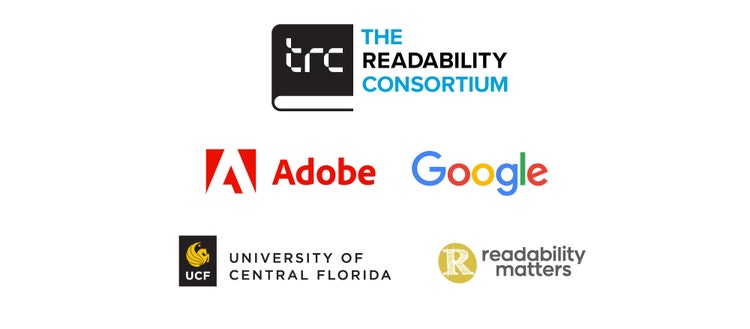Adobe announces readability consortium with Google and UCF to improve reading for all

Reading is foundational to acquiring knowledge and sharing ideas, but most people cannot read proficiently. That’s a major problem. In fact, 130 million U.S. adults ages 16 to 74 (54 percent) lack proficiency in literacy, reading below a sixth-grade level.
To help address this, Adobe formed The Readability Consortium with founding members University of Central Florida (UCF) and Readability Matters, and welcomed Google as its newest member. Our aim with The Readability Consortium is to make digital reading and reading comprehension more equitable for all people across the globe by investing in cognitive research, open-source tools, and user testing across a wide swath of age groups and abilities levels.
We will bring together for-profit and non-profit companies, educators and researchers, and government entities to advocate for the advancement of individualized digital reading experiences across all devices and develop solutions which will address the fundamental issues with displaying fixed text. Because even for people who do read well, many experience eye strain, fatigue, or simply struggle to keep up with the volume of reading that life requires.
Four years ago, we embarked on this mission with the goal of making everyone a better reader through individualized reading formats. Through our initial partnership with the nonprofit Readability Matters, we tested an individualized text formatting prototype with 80 San Jose students and saw amazing results. Struggling readers became proficient readers, and proficient readers became even better readers. Students who were essentially non-readers showed that they, in fact, could read when text was individualized.
Once we saw the potential of customized reading formats, we knew we wanted to provide some of these benefits to our customers — and you will find some of those features in Acrobat’s Liquid Mode today. But we quickly realized that we were raising even more questions:
- Which reading formats work best, and how do we determine those formats?
- Are there a handful of formats to choose between or do we need customization on an individual level?
- Can readers find their best format on their own, or do we need new diagnostic tools?
- Can custom formatting help students make up for interrupted reading progress due to the pandemic?
Answering these types of questions has become our passion and has resulted in forming a research community not only at Adobe, where Dr. Zoya Bylinskii heads up our efforts, but in funding the Virtual Readability Lab at the University of Central Florida under the direction of Dr. Ben Sawyer. And we have pulled together an informal network of more than 50 researchers around the world sharing new research, building new tools, and forming new collaborations. And these questions are increasingly important. According to the United Nations, COVID-19 has wiped out 20 years of education gains. An additional 101 million (nine percent) of children in grades 1-8 fell below minimum reading proficiency levels in 2020.
Our research has shown that even for a skilled reader, choosing the ideal format can improve their reading as much as 239 words per minute. That’s like reading War and Peace in 18 hours vs. 35 hours.
Our goal is to continue to build a research effort encompassing new tools, new methods, and to create the world’s largest reading behavior data set. This will lead to a new set of eye tests that will enable anyone to find their best reading “prescription” and use it anytime they read digital text. This will be a massive multi-year undertaking, and we need to work with more tech companies, educational institutions, publishers, and news organizations to solve for all digital reading tools and surfaces.
At Adobe, we are focused on how our tools, technology and platform can transform the world. We are committed to the responsible use of technology, ensuring that the innovations we create and bring to market are ethical, trustworthy and positively contribute to society. As a pillar of our Technology to Transform efforts, we intend to make reading better for everyone: to help those struggling to read proficiently and to empower those proficient readers to read even better — more efficiently, with less strain, with less fatigue.